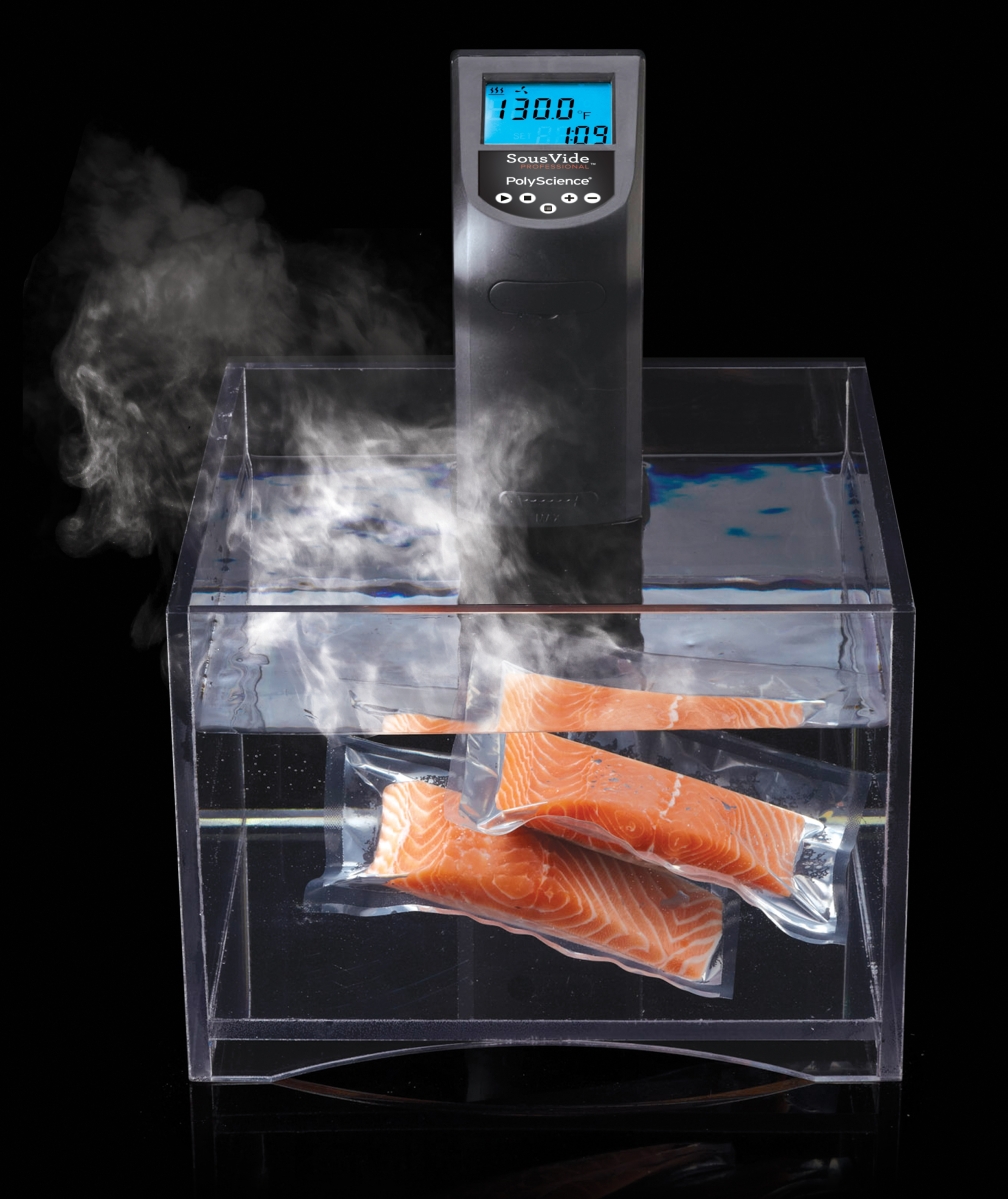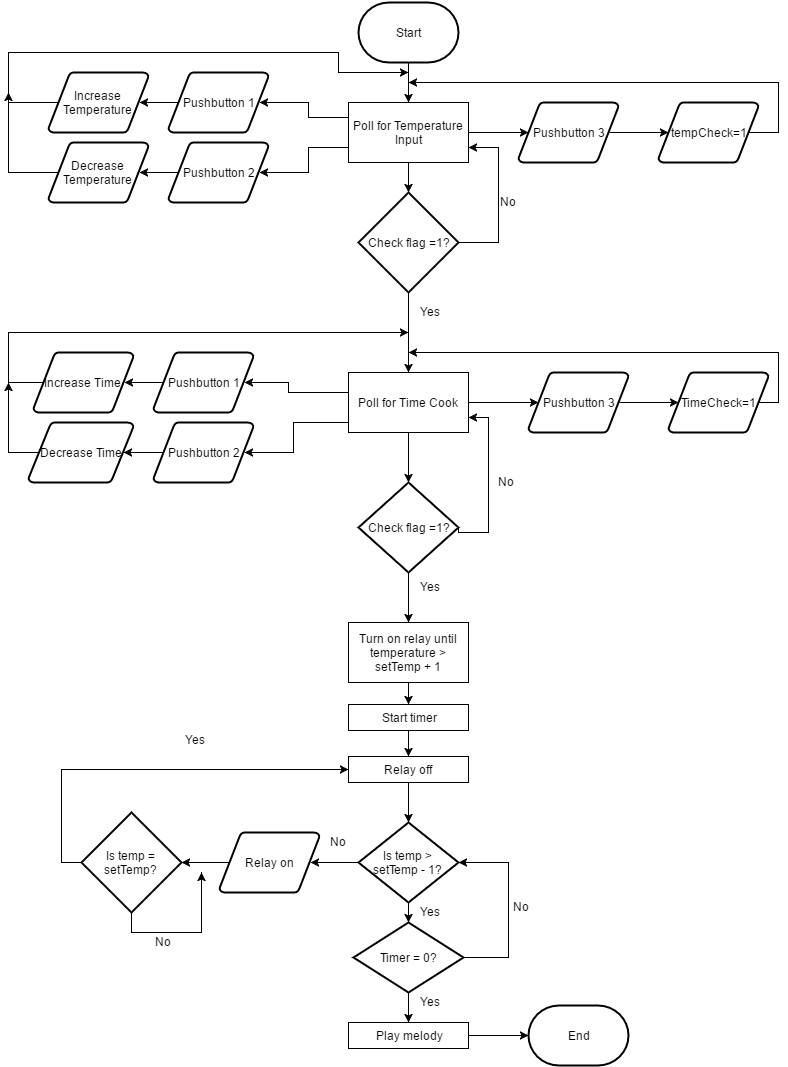mbed Sous-Vide
Page last updated 23 Aug 2017, by .
0
replies
cook,
cooking,
food,
powerswitch tail,
Relay,
sous vide,
Temperature
ECE 4180 Final Project:
- Utilizing the mbed for temperature controlled long duration, low heat sous-vide cooking technique using a slow cooker, a PowerSwitch Tail II, and a DS18B20 waterproof high temperature sensor.
- Project By: Minsuk Chun (Section B), Richard Lee (Section B), Tianhang Ren (Section B)
What is Sous-Vide?
- Sous-Vide is a method of cooking in which food is sealed in airtight bags and placed in a temperature controlled water bath environment for a prolonged period of cooking from under 1 hour to up to 48 hours. The environment is at an accurately regulated temperature much lower than normally used for cooking times, which allows for items to cook evenly and consistently, ensuring the inside is properly cooked without overcooking the outer layer while retaining moisture.

Components Needed for Project
- PowerSwitch Tail II:
- A low-cost module designed to switch AC loads such as household lights and appliances using a digital logic control signal.
- DS18B20 waterproof high temperature sensor:
- A sealed digital temperature probe lets you precisely measure extreme temperatures in wet environments with a simple 1-Wire interface.
- Slow Cooker:
- Allows for slow cooking on various settings for prolonged use with low power consumption.
- uLCD-144-G2 or any LCD display board:
- Used to display command prompts and real time information of the temperature and cooking time.
- Three Parallax push buttons or any alternative push buttons:
- Used for user inputs to adjust the cooking temperature and time.
- Speaker:
- Used for user feedback when interacting with push buttons and notify milestones of the cooking process.
- Misc. Resistors for pull ups:
- Used for push buttons and transistor for powering of speaker
Wiring: DS18B20 Temperature Sensor
| Pin on Breakout | Pin on mbed |
|---|---|
| GND (White) | GND |
| VIN (Orange Stripe) | VU or Vout |
| DATA (Blue) | p5 |
Wiring: Powerswitch Tail II
| Powerswitch Tail II | Pin on mbed | AC Device | Wall Outlet |
|---|---|---|---|
| 2 -in | GND | ||
| 1 +in | p8 | ||
| 3 (AC) gnd | |||
| AC Female Plug | AC Male Plug | ||
| AC Male Plug | AC Wall Socket |
Circuit Diagram

- Note that the DS1820 waterproof sensor is identical to the TMP36 and the latter is used here.
- The relay used is used as a standin device for the Powerswitch Tail II as the circuit is too large to fit.
Code Block

Code
Import programSousVide
Using mbed for sous vide
main.cpp
#include "mbed.h"
#include "uLCD_4DGL.h"
#include "Speaker.h"
#include "DS1820.h"
#include "PinDetect.h"
#include <time.h>
//Program by: Tianhang Ren, Minsuk Chun
////////////////////////////////////////////////////////
//Initialize
///////////////////////////////////////////////////////
DS1820 probe(p5);
PinDetect pbUp(p18); // Buttons to raise/lower/enter temperature
PinDetect pbDown(p19);
PinDetect pbEnter (p20);
Serial pc(USBTX, USBRX); // serial comms over usb back to console
//Timer T;
DigitalOut myled1(LED1); // On when relay is engaged
DigitalOut myled2(LED2);
DigitalOut myled3(LED3);
DigitalOut myled4(LED4);
uLCD_4DGL uLCD(p28, p27, p29); // create a global uLCD object
DigitalOut ctrl(p8); //relay control
// setup instance of new Speaker class, mySpeaker using pin 21
// the pin must be a PWM output pin
Speaker mySpeaker(p26);
float userTemp = 0; //user desired temperature of device
int check = 0; //indicates whether enter key is pressed
float timeCook = 0;
////////////////////////////////////////////////////////
// Initialize pushbuttons
///////////////////////////////////////////////////////
// Callback routine is interrupt activated by a debounced pb1 hit
void pbUp_hit_callback (void)
{
// CODE HERE WILL RUN WHEN INTERUPT IS GENERATED
myled1 = !myled1;
mySpeaker.PlayNote(400.0,0.25,0.1);
userTemp++;
timeCook +=5; //TODO CHANGE TIME BACK TO 10 INTERVALS
}
// Callback routine is interrupt activated by a debounced pb2 hit
void pbDown_hit_callback (void)
{
// CODE HERE WILL RUN WHEN INTERUPT IS GENERATED
myled2 = !myled2;
mySpeaker.PlayNote(200.0,0.25,0.1);
userTemp--;
if (userTemp <=0) {
userTemp = 0;
}
timeCook-=5;
if (timeCook <=0)
timeCook=0;
}
// Callback routine is interrupt activated by a debounced pb3 hit
void pbEnter_hit_callback (void)
{
// CODE HERE WILL RUN WHEN INTERUPT IS GENERATED
myled3 = !myled3;
mySpeaker.PlayNote(800.0,0.10,0.1);
mySpeaker.PlayNote(1000.0,0.10,0.1);
mySpeaker.PlayNote(1200.0,0.10,0.1);
check++;
}
////////////////////////////////////////////////////////
// Main method starts here
////////////////////////////////////////////////////////
int main()
{
//setup three SPST push buttons
pbUp.mode(PullUp); //add internal pullup resistor
pbDown.mode(PullUp);
pbEnter.mode(PullUp);
// Delay for initial pullup to take effect
wait(.01);
// Setup Interrupt callback functions for a pb hit
pbUp.attach_deasserted(&pbUp_hit_callback);
pbDown.attach_deasserted(&pbDown_hit_callback);
pbEnter.attach_deasserted(&pbEnter_hit_callback);
// Start sampling pb inputs using interrupts
pbUp.setSampleFrequency();
pbDown.setSampleFrequency();
pbEnter.setSampleFrequency();
// pushbuttons now setup and running
////////////////////////////////////////////////////////
// Ask for temperature and time desired
////////////////////////////////////////////////////////
uLCD.printf("Enter desired temperature"); //Ask for desired temperature
while(check ==0) { //if check flag is 0, means enter has not been pushed
if (pbUp) {
uLCD.locate(0,3);
uLCD.printf("%4.0f", userTemp);
}
if (pbDown) {
uLCD.locate(0,3);
uLCD.printf("%4.0f", userTemp);
}
}
float finalTemp = userTemp; //reassign to final temp
check = 0;
uLCD.cls();
uLCD.locate(0,0);
timeCook = 0; //reset timeCook
uLCD.printf("Enter cooking time"); //Cooking time in minutes
while (check == 0) {
if (pbUp) {
uLCD.locate(0,3);
uLCD.printf("%4.0f", timeCook);
}
if (pbDown) {
uLCD.locate(0,3);
uLCD.printf("%4.0f", timeCook);
}
}
float finalTime = timeCook *60; //reassign to final time
ctrl = 1; // Turn on relay
float tempLimit = 0; //intitialize variable to track temperature
uLCD.locate(0,0);
uLCD.printf("Set Temp (C)", finalTemp); //print set temperature
while (tempLimit < (finalTemp + 1)) { //Loop while temperature is 1 degrees over destination
probe.convertTemperature(true, DS1820::all_devices); //Start temperature conversion, wait until ready
tempLimit = probe.temperature();
uLCD.locate(0,3);
uLCD.printf("It is %3.1foC\r", probe.temperature());
wait(1);
}
////////////////////////////////////////////////////////
// Start cooking with finalized temperatures and time
////////////////////////////////////////////////////////
//PLAY SOUND FROM SPEAKER
/* T.start(); //Timer start (s)*/
float time_remaining = 1;
ctrl = 0;
uLCD.cls();
uLCD.locate(0,0);
uLCD.printf("Set Temperature %4.0foC\r", finalTemp);
set_time(1256729737); // Set RTC time to Wed, 28 Oct 2009 11:35:37
// time_t seconds = time(NULL);
while(time_remaining > 0) { //Loop while timer has not reached desired time
if (tempLimit < (finalTemp - 1)) { //If temperature is 2 degrees C lower than desired, turn relay on
ctrl = 1;
} else if (tempLimit >= finalTemp) {
ctrl = 0;
}
tempLimit = probe.temperature();
probe.convertTemperature(true, DS1820::all_devices); //Start temperature conversion, wait until ready
uLCD.locate(0,3);
uLCD.printf("It is %3.1foC\r", probe.temperature());
uLCD.locate(0,5);
time_t seconds = time(NULL); //Cycle RTC
time_remaining = finalTime - (seconds - 1256729737);
if ((time_remaining/3600) >= 1 )
uLCD.printf("Time remaining: \n%4.0f hours", time_remaining/3600);
else if ((time_remaining/60) >= 1)
uLCD.printf("Time remaining: %4.0f minutes", time_remaining/60);
else
uLCD.printf("Time remaining: %4.0f seconds", time_remaining);
}
ctrl = 0;
//PLAY SOUND FROM SPEAKER
mySpeaker.PlayNote(1567.98,0.25,0.1);
mySpeaker.PlayNote(1046.50,0.25,0.1);
mySpeaker.PlayNote(1174.66,0.25,0.1);
mySpeaker.PlayNote(1318.51,0.25,0.1);
mySpeaker.PlayNote(1396.91,0.25,0.1);
mySpeaker.PlayNote(1567.98,0.25,0.1);
mySpeaker.PlayNote(1046.50,0.25,0.1);
mySpeaker.PlayNote(1046.50,0.25,0.1);
mySpeaker.PlayNote(1760.00,0.25,0.1);
mySpeaker.PlayNote(1396.91,0.25,0.1);
mySpeaker.PlayNote(1567.98,0.25,0.1);
mySpeaker.PlayNote(1760.00,0.25,0.1);
mySpeaker.PlayNote(1975.53,0.25,0.1);
mySpeaker.PlayNote(2093.00,0.25,0.1);
mySpeaker.PlayNote(1046.50,0.25,0.1);
mySpeaker.PlayNote(1046.50,0.25,0.1);
uLCD.cls();
uLCD.locate(0,0);
uLCD.printf("Food is ready");
}
Demo Video
Where to Buy Components:
- PowerSwitch Tail II: https://www.adafruit.com/product/268
- DS18B20 waterproof high temperature sensor: https://www.adafruit.com/products/642
- Slow Cooker: Any slow cooker can be used
- uLCD-144-G2: http://www.4dsystems.com.au/product/uLCD_144_G2/
- Parallax push buttons: https://www.sparkfun.com/products/97
- Speaker: https://www.sparkfun.com/products/9151
Please log in to post comments.
